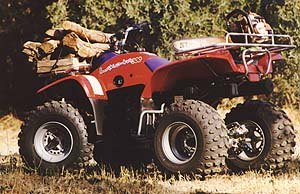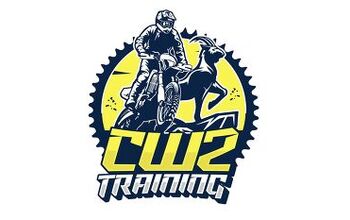ATV Test: 1997 Kawasaki Lakota 300 - Motorcycle.com
For many years, almost all ATVs on the market were geared toward either specialized play or pure work. But trends change quickly and, similar to the automotive industry, a new class unheard of just a few short years ago has emerged -- the Sport-Utility Vehicle (SUV) -- that successfully bridges the gap between work and play.
By nature, however, sport-utes involve compromises. They are rarely able to perform both jobs with equal proficiency. One category, be it work or play, is usually handled better by the machine at the expense of the other. But it seems more and more enthusiasts are looking beyond these shortcomings.
We're not obliged to love SUVs, but you have to admit they're handy, they're becoming increasingly popular, and as such, they can't be ignored.
Enter Kawasaki's Lakota 300, an ATV Team Green admits is more utility oriented. "Sixty-forty," a Kawasaki spokesman told us. "The Lakota was designed to be 60 percent utility, 40 percent sport. We like to call it our 'playful workhorse.' First introduced in 1995, the Lakota is actually a mix of two other quads from Kawasaki's stable -- the sporting Mojave 250 and the all-utility Bayou 300.
Lakota's backup recoil starter is awkward to use, but effective. The Lakota's 290cc air-cooled motor comes courtesy of the Bayou. To enhance the Lakota's sporty side, a larger cam with more intake timing is used, and in the transition to SUV Kawasaki switched final drive to chain from the Bayou's shaft. Also carried over from the utility quad is the semi-auto five-speed gearbox with dual clutches and 2WD. Reverse on the Lakota is activated by simply shifting down from neutral. Nice and easy, the way it should be.
"Frame and suspension on the Kawi SUV were lifted right off their Mojave 250 sportster."
Frame and suspension on the Kawi SUV were lifted right off their Mojave 250 sportster, featuring independent double wishbone front suspension with 6.9 inches of wheel travel and a longer swingarm than that on the Mojave for increased wheelbase, and thus stability. The gas-charged rear shock features only spring preload adjustability and comes with 8.5 inches of bump-soaking wheel travel. The Lakota is equipped with tallish Goodyear Wrangler Sport tires in AT22x8-10 front and AT22x11-10 rear sizes. We think Kawasaki was close to the money when they labeled the Lakota "60-40" biased. In a pure-sport environment, there are several things that hold the Lakota back from being a great recreational performer. Blasting down a trail at speed, taller riders will find the cockpit accommodations cramped, with seat-to-peg distance too short.
When we're out sport riding on a quad we prefer to wear MX boots, and the Lakota's shift lever is just too short and too far back for aggressive trail work with this kind of footgear.
Also, the rear utility rack is positioned too close to the seat, interfering with the rider's ability to hang off while cornering hard. However, both the front and rear racks are easily removable.
The Lakota's cramped cockpit is simple and well laid out. With the Lakota's short wheelbase, best to lean WAY off.
When used in utility mode, there's plenty of power on tap and the Lakota pulls loads with authority. The auto-clutch/manual shift set-up is easy to use in a working environment, but is not ideal for sporting use.
Even though the Lakota is fitted with a longer swingarm, it still has a fairly short wheelbase for a mid-size SUV and feels tippy during spirited cornering, no doubt aided by its tall rubber. Lots of body English is required when traversing off-camber corners at speed. A big plus for the Lakota during sport trailing is its excellent long-travel suspension. The machine tracks straight and true through high-speed whoops and is able to hold a tight line when pitched into a corner.
Over-steer is easy to invoke in the lower gears: just a whack of the throttle lever and a flick of its light-steering bars and you can practically turn in place (making doughnuts especially satisfying). When it's time to haul the Lakota down from speed for that next corner, or tree, or ravine, its triple disc brakes are second to none, providing quick, sure stops. The Lakota was a blast to rail through MO's MX test track -- we just wish it had another gear.
"Its standard front and rear racks are sturdy, rated at a total carrying capacity of 110 pounds, and feature handy tie-down hooks."
Once back at the ranch we load up the Lakota and put it to work. Its standard front and rear racks are sturdy, rated at a total carrying capacity of 110 pounds, and feature handy tie-down hooks. As mentioned above, the seating is a little cramped but seat comfort itself is good, allowing for long spells in the saddle while trundling up a gnarly trail to that favorite fishing hole. Its short wheelbase makes tight maneuvering around the ranch a breeze.
Good ground clearance coupled with the new, stronger skid plates mean its vulnerable rear sprocket and brake disc receive maximum protection even when loaded to the rafters. The Lakota's backup recoil starter, a necessity on any quad with utilitarian pretensions, starts the single-cylinder machine easily enough, but its placement is awkward to use. Air filter access too, is compromised by Kawasaki's complicated plastic fuel tank cover design, requiring the removal of several screws and the entire tank cover just to get at the filter. Minor nitpicks aside, the Lakota fully measures up to its "60-40" rating for a sport-ute, functioning well as light utility machine. As we mentioned earlier, SUVs are a compromise, and Kawasaki's Lakota 300 is no exception. A fairly well-balanced machine, its playful chassis and excellent suspension make it a competent trail quad, but good carrying capacity, torquey motor, ease of use and the ability to handle any job thrown its way make it an even better workhorse. As far as mid-sized sport-utility quads go, you're not obliged to love the Lakota, but it can't be ignored.
Specifications:
Manufacturer: KawasakiModel: 1997 Lakota 300Price: ,549Engine: air-cooled, sohc, four-stroke singleBore and Stroke: 76 x 64mmDisplacement: 290ccCarburetion: Keihin CVK32Transmission: 5-speed w/ reverseFinal Drive: ChainWheelbase: 44.9 in.Ground Clearance: 7.7 in.Seat Height: 30.6 in.Fuel Capacity: 2.2 gal.Claimed Dry Weight: 459 lbs
More by Motorcycle Online Staff





































Comments
Join the conversation